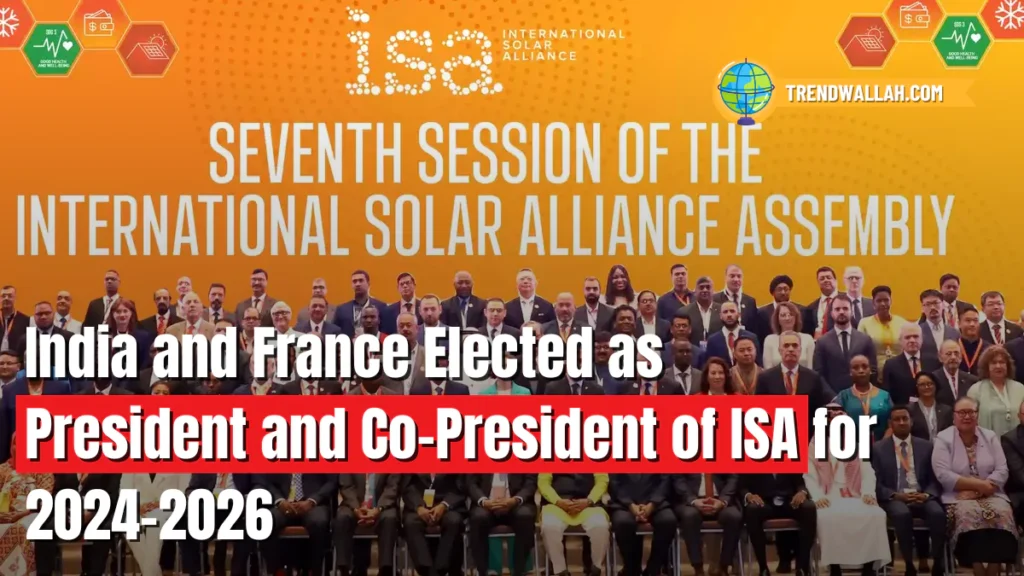
India and France elected as President and Co-President of ISA- the International Solar Alliance (ISA) for the term 2024-2026. India, being the sole candidate, won the presidency, while France claimed the co-presidency in a competitive race against Grenada. This significant election underscores India’s leadership in advancing global solar initiatives and renewable energy adoption.
Key Election Results
- ISA President: India was unopposed for this role.
- ISA Co-President: France won the position, surpassing Grenada in the race.
Highlights of the 7th ISA Assembly
The Seventh Session of the ISA Assembly is taking place from 3rd to 6th November 2024, at Bharat Mandapam, New Delhi. Attended by ministers and representatives from 29 countries, the assembly discusses goals for expanding solar energy and its global impact. Union Minister Pralhad Joshi, who represents India as ISA President, emphasized India’s dedication to global solar advancement, particularly under Prime Minister Modi’s leadership in solar project investments.
ISA’s Vision and Future Goals
With India and France at the helm, ISA aims to accelerate solar energy initiatives globally. The alliance has set a target to mobilize $1,000 billion by 2030 to support extensive solar energy adoption, lower costs, and drive technological innovations.
Vice Presidents and Vice Chairs
ISA has appointed Vice Presidents from each geographical region:
| Region | Vice Presidents | Vice Chairs |
| Africa | Ghana, Seychelles | South Sudan, Comoros |
| Asia-Pacific | Australia, Sri Lanka | UAE, Papua New Guinea |
| Europe and Others | Germany, Italy | Greece, Norway |
| Latin America & Caribbean | Grenada, Suriname | Jamaica, Haiti |
New Director General of ISA
Ashish Khanna has been designated as the next Director General of ISA, succeeding Ajay Mathur in March 2025.
ISA’s Support for LDCs and SIDS through Demonstration Projects
Since 2020, ISA has launched demonstration projects focused on solar technology applications in Least Developed Countries (LDCs) and Small Island Developing States (SIDS). These projects support countries like Bhutan, Burkina Faso, and Mauritius in building local capacity for sustainable solar solutions.
Viability Gap Funding (VGF) for Solar Projects
ISA’s VGF scheme offers financial grants covering 10-35% of solar project costs for LDCs and SIDS, with countries identifying eligible projects and securing 90% of the project funding independently.
India’s “Panchamrit” Climate Pledge at COP26
India’s 2021 “Panchamrit” pledge at COP26 includes commitments such as achieving 500 GW of non-fossil fuel capacity by 2030 and reaching net-zero emissions by 2070. These ambitious goals align closely with ISA’s mission to promote renewable energy for climate action.
India and France Elected as President and Co-President of ISA Key Points
- India and France elected as ISA President and Co-President for 2024-2026.
- ISA’s Assembly in New Delhi hosts representatives from 29 countries.
- Eight Vice Presidents appointed from ISA’s four global regions.
- New Director General Ashish Khanna to take office in March 2025.
- ISA’s VGF scheme supports solar projects in LDCs and SIDS.
- India’s “Panchamrit” pledge aligns with ISA’s renewable energy goals.
Also Read Latest Current Affairs 2024
Canara Bank Targets ₹6,000 Crore Recovery in H2 FY25
| IPL 2025 Retention List Announced | Ravindra Jadeja Became India’s Fifth-Highest Wicket-Taker |
| Sheikh Naim Qassem Becomes Hezbollah’s New Secretary | Duma Boko Elected as Botswana’s New President |
FAQs on India and France Elected as President and Co-President of ISA
ISA aims to promote large-scale solar energy deployment worldwide by mobilizing $1,000 billion by 2030.
India and France’s contributions to solar energy and their leadership roles in renewable initiatives led to their election.
ISA’s VGF scheme provides financial grants covering 10-35% of project costs for solar projects in LDCs and SIDS
Ghana and Seychelles are the Vice Presidents for Africa, with South Sudan and Comoros as Vice Chairs.
India’s pledge includes achieving 500 GW of non-fossil capacity by 2030 and net-zero emissions by 2070.
